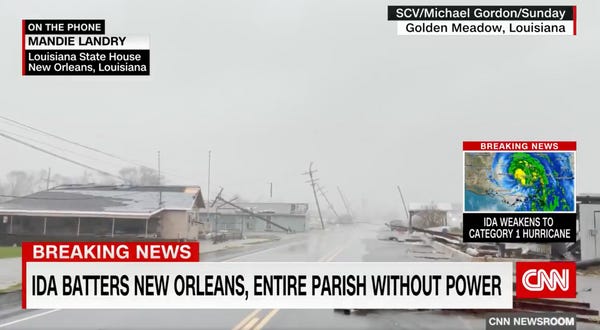The Levees Held But The Power Grid Failed In New Orleans
At least a million people without power in Lousiania.
Hurricane Ida whomped the northern Gulf Coast Sunday, and the extent of the damage is undetermined, as parts of Louisiana remain flooded and unreachable. Although Ida was downgraded today to a tropical storm, it's left its mark as one of the most ferocious hurricanes to hit the mainland, and this includes Katrina in 2005.
From the New York Times:
"It's never been as bad as it is this time," said Jesse Touro, 62, who was rescued from Jean Lafitte after riding out storms in town for the past 12 years. He sounded exhausted as he rode a parish bus to find some sort of shelter. "None of them like this one," he repeated.
According to the Times , New Orleans was “bruised but not beaten" by Ida: "In the French Quarter, the streets seemed to have been washed almost clean," which sounds like the reporter was channeling Travis Bickle. The French Quarter was also originally built on land just slightly above sea level, as settlers understood the value of the high ground. However, New Orleans as a whole is steadily sinking, but that's not the biggest problem the city's facing right now. More than a million people are without power in Louisiana — at least 787,000 just in New Orleans alone.
Midnight @cnni call on what’s going on in Nola and nearby below ⬇️ #lalege https: //t.co/VtX3ZVMW4M
— Mandie Landry (@Mandie Landry) 1630327437.0
This is more than just inconvenient. Louisiana House Rep. Mandie Landry, who serves District 91 in New Orleans, explained on CNN Monday night that residents can't even see the scope of the damage.
LANDRY: We had several hours of intense, terrifying wind today, branches flying around. Outside furniture flying around that people didn't tie down. That's over for now, but what's also scary is that we can't quite see the damage because it's so dark. I wish I could join you by video but as you said, there's literally no electricity in the entire city. We're all sitting here in the dark just hoping for the best tomorrow.
Unfortunately, a better tomorrow is perhaps weeks away, according to officials. Ida knocked out all eight transmission lines that deliver power to New Orleans, in a cruelly ironic commemoration of Katrina's 16th anniversary. Jazz Fest was postponed because of COVID-19, but it looks like Ida would've cancelled the party anyway.
Louisiana Governor John Bel Edwards' office described the damage to the power grid as “catastrophic," and hospitals — already pushed to the brink thanks to the recent COVID-19 surge — must rely on generators, as will any businesses that try to remain open. Individuals now face temperatures expected to reach 90 degrees without air conditioning or refrigeration.
Why did the power grid fail so spectacularly? The utility company Entergy opened a new natural gas power plant in New Orleans last year that was supposed to keep the power on in an emergency. Maybe the city should've given the contract to a company named “Energy." Entergy sounds like an off-brand product like Dr. Perky or Fruity Hoops.
[Entergy] was one of two natural gas plants commissioned in recent years in the New Orleans area, the other one hailed by Gov. John Bel Edwards last year as a "source of clean energy that gives our state a competitive advantage and helps our communities grow."
Entergy pledged that it would “help keep the lights on — even during hot summer days and big storms. " This promise was sadly unkept.
Former New Orleans City Council member Susan Guidry had voted against the Entergy plant, and while she's not dropping “I told you sos," she did reveal that she worried Entergy couldn't cope with a storm like Ida, and she advised the city to consider other options, but her fellow Council members and Entergy ignored her warnings.
"They said that they had dealt with that problem," Ms. Guidry said. "The bottom line is they should have instead been upgrading their transmission and investing in renewable energy."
Storms like Ida will only occur more frequently because of climate change, which too many politicians and their donors want to ignore. Meanwhile, the only people currently with power in the affected areas are those who had the foresight and the funds (mostly the latter) to invest in personal generators and solar panels. This is why investments are needed across-the-board in rooftop solar, batteries, and microgrids, so private residences and commercial buildings can have power even if the larger grid fails. Infrastructure Week can't come quickly enough.
[ New York Times ]
Follow Stephen Robinson on Twitter.
If you enjoyed this story, please donate what you can to keep Wonkette going forever!



You clearly have never tried to walk on the stuff they dredge, much less build on it.
One of my main gripes about the infrastructure package is the reliance on beefing up the grid, when the reality of it is that if we distribute power generation everywhere (primarily solar and medium scale wind) then we don't need huge grids. The current model is all about last century's technology and the desire to capture customers, and while we do need to change where the grid is going as wind farms usually have a problem getting power to the places that use it, we need to work on a more distributed model as it will be more resilient.
Of course it doesn't help if your solar panels blow away along with your roof.